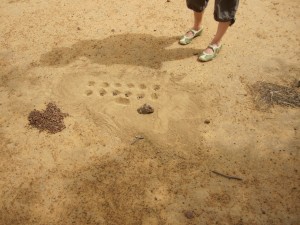
Finding refuge in the shade of a Baobab tree, we discover a makeshift board setup of Mancala.
The title of this blog today appears at the front of Simha Arom’s African Polyphony and Polyrhythm. It is attributed to Levi-Strauss and I agree with this statement. That is what I’m trying to do here. Take Mr. Arom’s analysis of the music of the Banda Linda and synthesize it. By writing about it, talking with friends and looking at my own music and the work of others through the lens of an ethnomusicologist I hope to see and hear sound differently.
Gyorgy Ligeti wrote the forward to African Polyphony and Polyrhythm because of “the proximity [he] feels exists between it and [his] own way of thinking with regards to composition: that is, the creation of structures which are both remarkably simple and highly complex.” Ligeti also mentions his fascination with the music from medieval Europe e.g. Machaut, Vitry, Ciconia. The medieval techniques of hocket and isorhythm are also found in many peoples of Africa. It is also interesting to note that it is a technique that in Western music fell out of fashion.
Ligeti writes that Simha Arom’s opens the door to a new way of thinking about polyphony which is “completely different from the European metric structures.” I heartily agree and this thought is what most fascinates and interests me. This ethnomusicological study of the peoples of the Central African Republic will I hope help me elucidate my approach to and understanding of music creation.
Perhaps what ultimately may be at the heart of my discovery is how we count. What are the similarities and differences? Why has their form of counting created their musical world described by Simha Arom as African Polyphony and Polyrhythm?
I look forward to seeing the proof.
Tags: Central African Republic, ethnomusicology, Levi-Strauss, Ligeti, Machaut, music, polyphony, polyrhythm, Simha Arom
Leave a comment